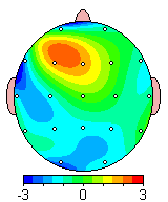Compelling research evidence exists that there is often a neurophysiological basis for depression, particularly in people with a family history of depression. Neuroscientists have discovered a particular brainwave pattern that allows us to identify individuals with a biological predisposition for developing depression. This biological marker appears to be very robust (Davidson, 1998a, b), having been replicated many times in brain mapping research utilizing quantitative electroencephalograms (QEEG) and other forms of neuroimaging. It has even been found in infants of mothers with a history of depression, compared with babies of women without a depression history (Dawson, Grofer Klinger, Panagiotides, Hill, & Spieker, 1992; Dawson, Grofer Klinger, Panagiotides, Spieker & Frey, 1992).
The left frontal area of the brain is associated with positive emotions and approach motivation, which is a desire to be involved with other people. The right frontal area of the brain is more associated with depression and fear, accompanied by motivation to withdraw from and avoid other people. When there is more slow brainwave activity in the left frontal area, this part of the brain is more inactive and the right frontal area is more dominant. Such a person is predisposed to become depressed more easily, to withdraw from other people, and to be anxious. This may occur because of heredity (family history) or because someone has had a concussion or mild head injury in the left frontal area which produced the slowing.
Part of a brain map from two different people is reproduced below. The map on the left is from a person with a long history of depression. You can clearly see in the left frontal area (which is colored orange and yellow) that there is an excess of slow, alpha brainwave activity. This is the pattern that has been classically associated with a vulnerability to depression. In contrast, the brain map on the right displays how a relatively normal map would look, without any excess or serious deficit.
 |
 |
It is interesting that research has found that antidepressants do not correct the type of brainwave pattern that we see above on the left. Thus, medication treatment for depression appears to still leave intact the biological predisposition for becoming more easily depressed when unpleasant life circumstances come along. There is also new evidence that has found that on average, antidepressant medications only have an 18% effect over and above placebo effects (Antonuccio, Danton, DeNelsky, Greenberg, & Gordon, 1999; Kirsch, Scoboria, & Moore, 2002; Kirsch & Sapirstein, 1998), and medication may only be mildly effective in treating anxiety as well (Antonuccio et al., 1999). In contrast, we know that psychotherapy for depression compares favorably with medication in short-term follow-ups (DeRubeis, Gelfand, Tang, & Simons, 1999) and appears to be superior in long-term follow-ups (Antonuccio, Danton, & DeNelsky, 1995; Hollon, Shelton, & Loosen, 1991).
Neurofeedback treatments for depression (Baehr, Rosenfeld, & Baehr 1997, 2001; Hammond, 2000, 2004) appear very promising not only in bringing relief from depression, but in modifying the underlying biological predisposition for becoming depressed. Neurofeedback focuses on retraining the brain, for example, reversing the frontal brainwave asymmetry, with the goal of producing an enduring change that does not require people to remain on medication indefinitely. Training often requires about 20 to 22 sessions.
Written by D. Corydon Hammond, PhD Professor & Psychologist, Physical Medicine & Rehabilitation University of Utah School of Medicine.
References
- Antonuccio, D. O., Danton, W. G., & DeNelsky, G. (1995). Psychotherapy vs. medication for depression: Challenging the conventional wisdom with data. Professional Psychology: Research & Practice, 26, 574-585.
- Antonuccio, D. O., Danton, W. G., DeNelsky, G. Y., Greenberg, R. P., & Gordon, J. S. (1999). Raising questions about antidepressants. Psychotherapy & Psychosomatics, 68, 3-14.
- Baehr, E., Rosenfeld, J. P., & Baehr, R. (1997). The clinical use of an alpha asymmetry protocol in the neurofeedback treatment of depression: Two case studies. Journal of Neurotherapy, 2(3), 10-23.
- Baehr, E., Rosenfeld, J. P., & Baehr, R. (2001). Clinical use of an alpha asymmetry neurofeedback protocol in the treatment of mood disorders: Follow-up study one to five years post therapy. Journal of Neurotherapy, 4(4), 11-18.
- Davidson, R. J. (1998a). Affective style and affective disorders: Perspectives from affective neuroscience. Cognition & Emotion, 12, 307-330.
- Davidson, R. J. (1998b). Anterior electrophysiological asymmetries, emotion, and depression: Conceptual and methodological conundrums. Psychophysiology, 35, 607-614.
- Dawson, G., Grofer Klinger, L., Panagiotides, H., Hill, D., & Spieker, S. (1992). Frontal lobe activity and affective behavior of infants of mothers with depressed symptoms. Child Development, 63, 725-737.
- Dawson, G., Grofer Klinger, L., Panagiotides, H., Spieker, S., & Frey, K. (1992). Infants of mothers with depressed symptoms: Electroencephalographic and behavioral findings related to attachment status. Development & Psychopathology, 4, 67-80.
- DeRubeis, R. J., Gelfand, L, A., Tang, T. Z., & Simons, A. D. (1999). Medications versus cognitive behavior therapy for severely depressed outpatients: Mega-analysis of four randomized comparisons. American Journal of Psychiatry, 156, 1007-1013.
- Hammond, D. C. (2000). Neurofeedback treatment of depression with the Roshi. Journal of Neurotherapy, 4(2), 45-56.
- Hammond, D. C. (2004). Neurofeedback treatment of depression and anxiety. Journal of Adult Development. (in press).
- Hollon, S. D., Shelton, R. C., & Loosen, P. T. (1991). Cognitive therapy and pharmacotherapy for depression. Journal of Consulting & Clinical Psychology, 59, 88-99.
- Kirsch, I., & Sapirstein, G. (1998). Listening to Prozac but hearing placebo: A meta-analysis of antidepressant medication. Prevention & Treatment, 1, Article 2. Available online at: http://www.journals.apa.org/prevention/volume1
- Kirsch, I., Moore, T. J., Scoboria, A., & Nicholls, S. S. (2002). The emperors new drugs: An analysis of antidepressant medication data submitted to the U.S. Food and Drug Administration. Prevention & Treatment, 5, Article 23. Available online at: http://www.journals.apa.org/prevention/volume5/pre0050023a.html.
- Kirsch, I., Scoboria, A., & Moore, T. J. (2002). Antidepressants and placebos: Secrets, revelations, and unanswered questions. Prevention & Treatment, 5, Article 33. Available online at: http://www.journals.apa.org/prevention/volume5/pre0050023a.html.